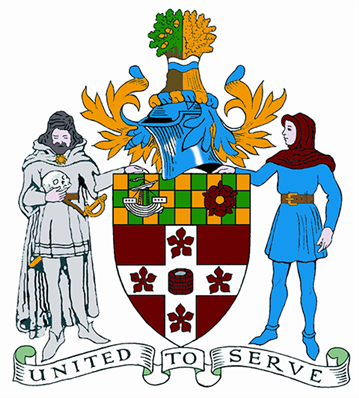The Mayor of Southwark
Southwark - London's Most Historic Borough
Southwark's status as ‘London's most historic borough’ comes from the fact that the original borough of Southwark was founded by King Alfred in 880 as one of thirty-three fortified places in England to defend the population from the Viking assaults. At that time, the ruins of Roman ‘Londonium’ were occupied by a Viking army and didn't come under Alfred’s control until 886. Therefore, Southwark as a ‘borough’ predates the ‘City of London’.

The Southwark coat of arms
On 15 August 1966, the Herald's College made a Grant of Arms to Southwark; this is the coat of arms you see in any correspondence from the Mayor of Southwark and the civic office and in all programmes or publicity material for civic events.
The coat of arms is an amalgam of elements of the three constituent Metropolitan Boroughs' arms (Southwark Council, formally established in 1965, was preceded by The Old Metropolitan Boroughs of Camberwell, Bermondsey, and Southwark).
The two supporters on the coat of arms are an Elizabethan player dressed to play Hamlet to the left, indicating the theatrical heritage of the area and the Shakespearean connection with The Globe Theatre in Southwark, and the youth on the right side is the Esquire from Chaucer's Canterbury Tales (Chaucer's long poem follows the journey of a group of pilgrims from the Tabard Inn in Southwark to St Thomas à Becket's shrine at Canterbury Cathedral).
The chequered band represents the three old boroughs of Camberwell, Bermondsey, and Southwark together. The colour combination is symbolic too. Green represents the historic, while gold stands for the modern.
The well in the centre of the shield is a 'canting'* reference to Camberwell and the four cinquefoils* represent the Dulwich area of Camberwell. The cinquefoils, or stylised flowers, also appear in the coat of arms of Edward Alleyn, the founder of Dulwich College and Alleyn's School.
The ship on the top left refers to the maritime history of Bermondsey and was part of the Rotherhithe insignia. The rose on the right is from the Southwark arms where it represented St Saviour's parish (now incorporated into Southwark's Anglican Cathedral parish). The cross, into which the well and cinquefoils are placed, was a common feature of Southwark and Camberwell, representing their Christian roots.
The crest at the top comprises a small oak tree and wheatsheaf bound together by a wavy silver and blue band. This symbolises the timber and food importing of the area - the wavy band indicating 'from overseas'.
The motto on the borough coat of arms is United to Serve, reflecting the commitment of the three old boroughs of Bermondsey, Camberwell, and Southwark to work together as one, and the commitment of council staff and public representatives to do likewise today.
The coat of arms may only be used by the Mayor, the Civic Office, and The Southwark Civic Association.
- * canting arms are heraldic bearings that represent the bearer's name in a visual pun or rebus; in this case, the visual pun is simply that of a well for Camberwell
- * a cinquefoil (from the French, meaning five-leaved) is a pattern in heraldry resembling a cinquefoil flower
Page last updated: 19 July 2024
